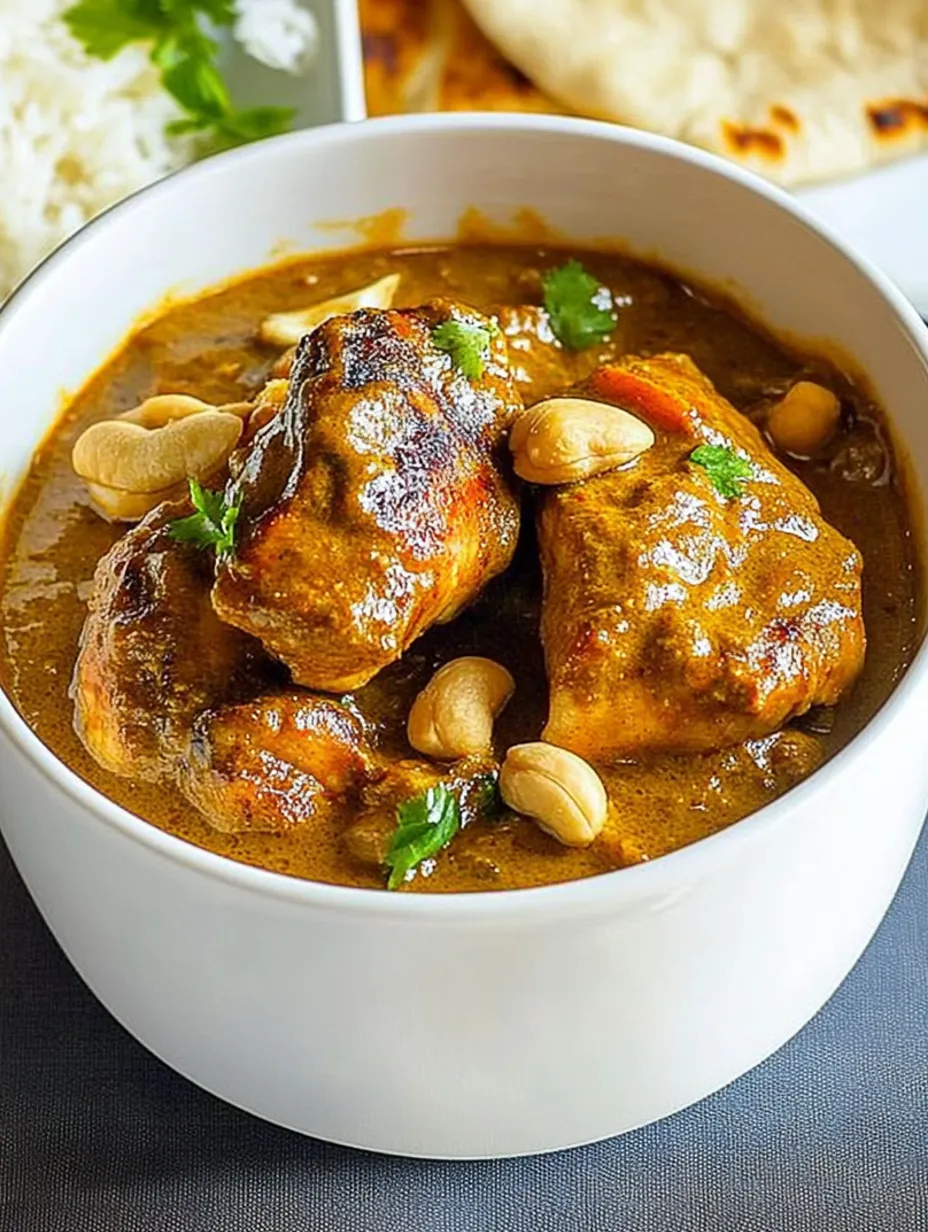 Pin it
Pin it
This flavorful chicken korma brings all the richness of classic Indian cuisine into your kitchen without overwhelming spice or complex techniques. I developed this simplified version after multiple attempts to recreate a memorable korma from my favorite local restaurant, focusing on balancing the aromatics with a creamy sauce that keeps everyone coming back for more.
This recipe became a staple in our home after my first attempt impressed even my spice-hesitant relatives. Now it makes an appearance at least monthly on our dinner table, especially when we need comfort food with a touch of elegance.
Ingredients
- Boneless skinless chicken thighs: for tenderness and richer flavor though breasts work well for a leaner option
- Garam masala: the signature spice blend that gives authentic Indian character to your korma
- Ground toasted cashews: providing natural thickening and nutty depth that distinguishes korma from other curries
- Coconut milk: creates silky richness essential to a proper korma sauce
- Plain yogurt: adds tangy creaminess while helping tenderize the chicken
- Fresh ginger root: offers bright punchy notes that balance the rich sauce use only fresh for best results
Step-by-Step Instructions
- Marinate the Chicken:
- Cut chicken into large bite sized pieces and combine with olive oil garam masala curry powder salt and pepper. Massage thoroughly ensuring every piece is well coated and allow to rest at least two hours ideally overnight for maximum flavor absorption.
- Grill the Meat:
- Cook the marinated chicken on a hot grill or grill pan until just cooked through with slight charring on the edges about 6 minutes per side. The chicken should register 165°F internally but still remain juicy. Set aside while preparing the sauce.
- Create the Aromatic Base:
- Blend onions and garlic with water until smooth then heat olive oil in a large heavy bottomed pot over medium heat. Add the onion puree and cook for 4 to 5 minutes until it loses its raw smell and begins to turn golden. This foundational step develops essential flavor compounds.
- Build the Sauce:
- Add diced tomatoes and grated ginger to the pot stirring frequently for about 3 minutes until tomatoes begin breaking down. Then incorporate ground cashews coconut milk yogurt and all remaining spices. The layering of these ingredients creates the complex flavor profile.
- Simmer and Develop Flavors:
- Reduce heat to medium low and simmer the sauce uncovered for 30 to 40 minutes stirring occasionally to prevent sticking. The sauce will thicken and darken slightly as flavors meld together and intensify.
- Complete the Dish:
- Add grilled chicken pieces to the simmering sauce folding gently to coat each piece. Continue simmering for another 10 to 15 minutes allowing the chicken to absorb the sauce flavors. Add chickpeas or vegetables in the last 10 minutes if desired.
 Pin it
Pin it
The ground cashews are truly the secret ingredient here. I discovered their importance after making a cashew free version that lacked the velvety mouthfeel that makes restaurant korma so crave worthy. Now I always keep toasted cashews on hand specifically for this recipe.
Spice Level Customization
Korma traditionally sits at the milder end of the curry spectrum making it perfect for those new to Indian cuisine. The recipe as written provides gentle warmth rather than heat. For those who enjoy spicier food increase the amount of minced red chili or add cayenne pepper in quarter teaspoon increments. Conversely for an extremely mild version omit the red chili completely and reduce the black pepper by half.
Vegetable Additions
Transform this chicken korma into a complete one pot meal by adding vegetables during the final cooking stage. Cauliflower florets bell peppers green peas and baby spinach all work beautifully. Harder vegetables like cauliflower should be added with the chicken while quick cooking vegetables like spinach can be stirred in just before serving.
 Pin it
Pin it
My family particularly enjoys the addition of sweet potatoes which I cube and partially cook in the microwave before adding to the simmering sauce. The sweetness complements the savory curry perfectly. For a vegetarian version simply omit the chicken and double the vegetable content.
Historical Context
Korma originates from Mughlai cuisine which developed during the Mughal Empire in South Asia. Traditional korma preparation involved braising meat in yogurt and stock with spices then finishing with cream. This cooking technique resulted in tender meat and a rich sauce ideal for soaking up with bread.
My modern adaptation streamlines the process while maintaining the essence of this historical dish. The combination of yogurt and coconut milk replaces the traditional cream but delivers similar richness. While purists might prepare a more complex version I find this simplified recipe captures the soul of korma while fitting into contemporary home cooking schedules.
Frequently Asked Questions
- → What makes chicken korma mild?
Chicken korma has a mild flavor profile due to its use of creamy ingredients like yogurt and coconut milk, balanced with warm spices like garam masala and turmeric without excessive heat from chilies.
- → Can I use chicken breasts instead of thighs?
Yes, chicken breasts work well in this recipe, but be careful not to overcook them to ensure they remain tender and juicy.
- → What are essential spices for korma?
Key spices for a korma dish include garam masala, turmeric, cinnamon, cardamom, ground coriander, and cloves for a balanced and aromatic flavor.
- → Can I make this dish vegetarian?
Absolutely, you can substitute chicken with chickpeas, cauliflower, bell peppers, or other vegetables to create a flavorful vegetarian version.
- → What is the best accompaniment for chicken korma?
Chicken korma pairs beautifully with steamed jasmine rice, naan, or even paratha. Garnishing with toasted cashews or almonds adds a crunch to the dish.
- → Can I prepare chicken korma ahead of time?
Yes, you can prepare the sauce a day or two in advance and refrigerate it. Add the cooked chicken and reheat gently before serving.
